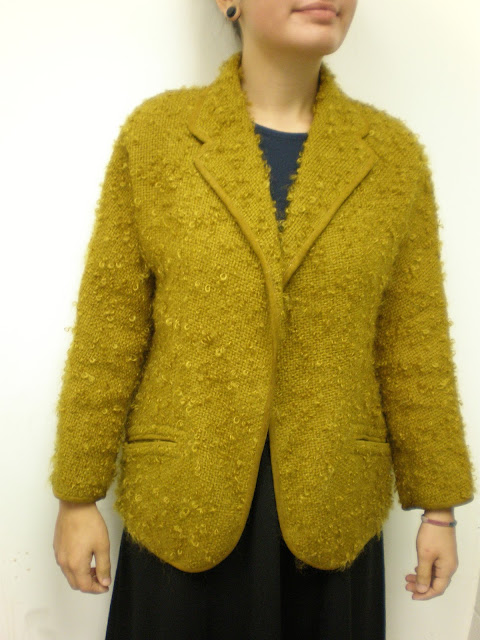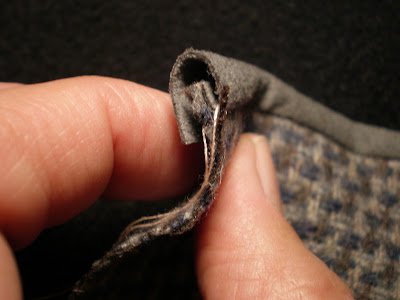Bonnie Cashin has been a fashion influence for generations. Her early career was highlighted by designing costumes for such movies as “Anna and the King of Siam”. It seems that researching this movie led her to the discovery of Asian styling. In that ‘look’ she found the basis for the lean and simple fashions that she is known for, a clean Asian inspired silhouette that was often bound in a flat leather edging. In this post I'll walk you through the process of making this same type of binding.
Cashin grew up in California during the 1930’s, spending time in Los Angeles before leaving for New York in the late 1940’s where she designed for fashion houses. It's at this time that her design patents can be found. By 1953 she was featured as a rising star, receiving a Coty award for her originality. Bonnie Cashin is among other American fashion innovators of the time, such as Claire McCardell and Rudy Gernreich who broke away from the French sense of fashion style to create an American sense of style.
In 1968 Cashin received another Coty award, and then in 1972, after over 20 years of design excellence, Bonnie Cashin reached the acclaimed status of the Coty American fashion critic’s Hall of Fame award. During this time her designs for Sill and Company were a fusion of luscious wools and leather.
The use of leather binding and seam line applications is a signature look for her Sills and Company designs. The trim, whether contrast or matching, tends to outline the structure and emphasize the linear quality of her garments.
Leather binding also provides the perfect foil for the rich texture and color of her many coats and jackets. By applying this same technique to simple garments, you can achieve a modern sense of elegant simplicity.
To create a coat or jacket, start with the textile, then determine the best use of color and texture for the edge trim. Cashin garments are trimmed in both suede and soft leather. Colors range from a very light contrast of tan or grey to dark blacks and navy. Complimentary matches are also seen, where the leather has been dyed to match the fabric.
Today we can use the convenience of artificial suede fabric such as Ultra Suede. Smooth leather may also be ‘salvaged’ from discarded skirts or pants found at thrift stores and cut into binding strips.
When sewing with light weight suede or leather, a conventional size 12 needle is usually sufficient.
This first slide shows an Ultrasuede strip that is 1" wide. It has been sewn along the fabric edge at 1/8" seam allowance with the 'good' side of both pieces facing together.
Binding strip length: To determine the length required, measure around all edges. The leather strip is joined at the following locations: Center back, Center Front roll line, Side seams. Using synthetic suede, you may be able to cut longer lengths that when leather was used on the originals. If you must have joins, use a string placed around the edge to determine where you will place your joins. Mark the string with a black pen dot, so that you can then measure that distance and cut each leather strip the correct length.
Binding strip width: You may need to experiment with samples to get the best look. On average, these are suggested widths to try:
Medium or thin fabric, cut suede 1” wide for ¼” wide edge: sew 1/8" from fabric edge
Thick wool: cut suede 1 ½” wide for 3/8” wide edge: sew 1/4" from fabric edge
After sewing the strip to the edge of the fabric, turn the long strip to the back side of fashion fabric and trim away any loose yarns. Roll the suede to the back side, covering the cut edge of the fabric. Make sure that the suede strip covers the stitch line by at least ¼”. Do not press leather in place.
Do not pin leather in place. Practice rolling it under by hand and holding the fabric to the back. Sewing on the front side, ‘stitch in the ditch’ down the edge of the binding. Your stitching should be against the suede, but sewn in the wool. I used my 'regular' presser foot, but a zipper foot may be required when the binding has bulk.
Turn the fabric over, face down (you will be looking at the back side) . Check to be sure that all of the suede edges are caught by the line of stitching. There should be about 1/8” of extra fabric in the seam allowance. If more is seen, trim this away by holding your scissors at a slant, cutting close to the stitching, but not catching the wool fashion fabric.
Curved edges:
When sewing binding around a curve, the leather will stretch if you sew it close to the edge. Roll the leather binding to the back side, smooth and lightly stretch the leather around the curve. If the fashion fabric you are using is loosely woven or tends to unravel, stay stitch on your sewing line before applying the leather trim. That should help to stabilize the curved surface.
Be careful not to tighten the stitch line as you sew around the curve, or that edge will curl or create a ‘bag’ effect in the fabric (stay stitching is a medium length stitch sewn right on the seam or sewing line to prevent stretching while handling and sewing the garment. It may be removed after sewing the garment if it shows).
Garment seam lines on Cashin coats are often soft and unlined. To create a clean interior, she often used flat fell seams. The width between the two seam lines is usually broad enough to accommodate the fullness of thickly textured wool.
Additional Sewing tips:
Flat Fell Seam allowances: Start with 1” wide seam allowances on thick weight wools. The inner seam allowance should be trimmed to about ½” wide; the longer 1” wide lap is folded over that. Trim the garment BACK seam allowances, leaving the garment FRONT seam allowances 1” wide. When sewn, the enclosed seam allowance is pressed towards the back. The flat fell top stitching is sewn about ½” from the original seam line. This should be sewn on the inside, so that the stitching follows the edge of the flat fell fold. (refer to a good sewing text to see examples of simple flat fell seam lines).
Credit: model- C.J. Jacobson
Additional articles on sewing CASHIN style:
Mohair coat pattern and how to make it
Pattern draft for leather and canvas coat
Brass twist locks
Twist locks on leather coats
1949 coat patent, 1970's coat pattern draft
my CASHIN board on Pinterest
final note: UCLA digital library online contains many photos of Cashin designs, undated.




















